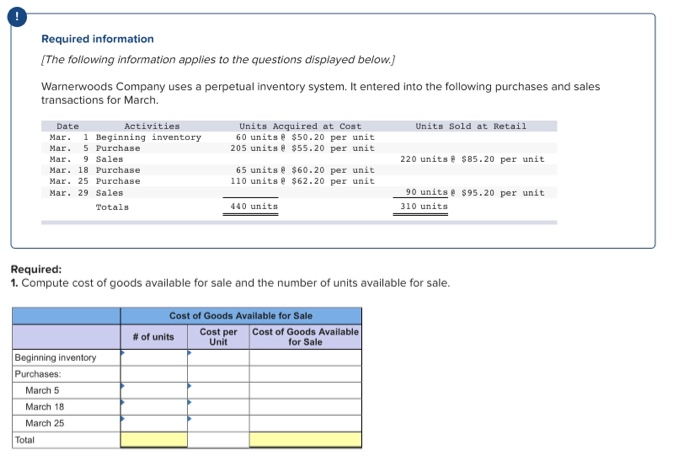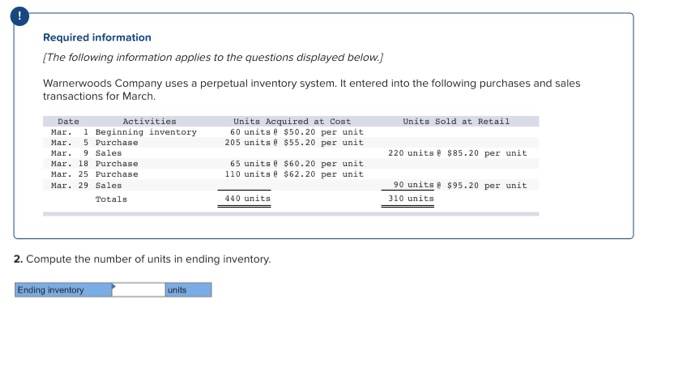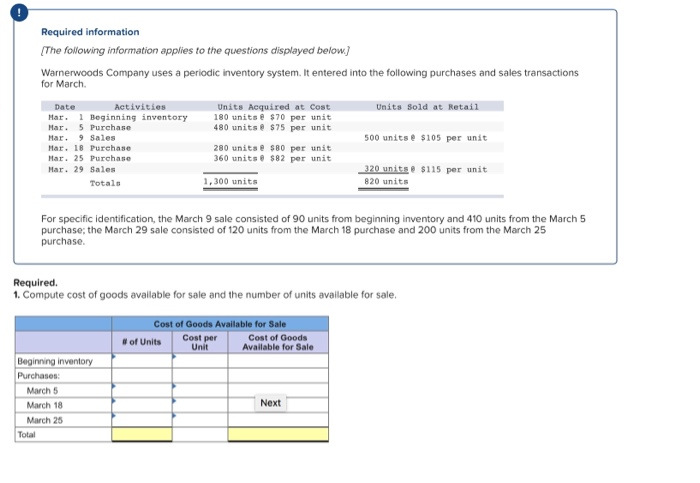Required information (The following information applies to the questions displayed below.) Warnerwoods Company uses a perpetual inventory system. It entered into the following purchases and sales transactions for March. Units Sold at Retail Units Acquired at Cost 60 units@ $50.20 per unit 205 units@ $55.20 per unit Date Activities Mar. 1 Beginning inventory Mar. 5 Purchase Mar. 9 Sales Mar. 18 Purchase Mar. 25 Purchase Mar. 29 Sales 220 units @ $85.20 per unit 65 units @ $60.20 per unit 110 units @ $62.20 per unit 90 unitse $95.20 per unit 310 units Totals 440 units Required: 1. Compute cost of goods available for sale and the number of units available for sale. Cost of Goods Available for Sale # of units cost per cost of Goods Available for Sale Beginning inventory Purchases: March 5 March 18 March 25 Total Required information The following information applies to the questions displayed below. Warnerwoods Company uses a perpetual inventory system. It entered into the following purchases and sales transactions for March Units Sold at Retail Units required at Cost 60 units @ $50.20 per unit 205 units @ $55.20 per unit 220 units @ $85.20 per unit Date Activities Mar. 1 Beginning inventory Mar. 5 Purchase Mar. 9 Sales Mar. 18 Purchase Mar. 25 Purchase Mar. 29 Sales Totals 65 units@ $60.20 per unit 110 units @ $62.20 per unit $95.20 per unit 90 units 310 units 440 units 2. Compute the number of units in ending inventory. Ending inventory units Required information The following information applies to the questions displayed below) Warnerwoods Company uses a perpetual inventory system. It entered into the following purchases and sales transactions for March Units Sold at Retail Units Acquired at Cost 60 units $50.20 per unit 205 units @ $55.20 per unit 220 unita $85.20 per unit Date Activities Mar. 1 Beginning inventory Mar. 5 Purchase Mar 9 Salon Mar. 18 Purchase Mar 25 Purchase Mar. 29 Sales Totals 65 units 110 units $60.20 per unit $62.20 per unit 90 unitse $95.20 per unit 310 units 440 units 4. Compute gross profit eamed by the company for each of the four costing methods. For specific identification, the March 9 sale consisted of 45 units from beginning inventory and 175 units from the March 5 purchase; the March 29 sale consisted of 25 units from the March 18 purchase and 65 units from the March 25 purchase. (Round weighted average cost per unit to two decimals and final answers to nearest whole dollar.) FIFO LIFO Avg. Cost Spec. ID Gross Margin Sales Less: Cost of goods sold Gross profit Required information The following information applies to the questions displayed below) Warnerwoods Company uses a periodic inventory system. It entered into the following purchases and sales transactions for March Units sold at Retail Units Acquired at Cost 180 units @ $70 per unit 480 units @ $75 per unit 500 units @ $105 per unit Date Activities Mar. 1 Beginning inventory Mar. 5 Purchase 9 Sales Mar. 18 Purchase Mar. 25 Purchase Mar. 29 Sales Totals 280 unitsesso per unit 360 units @ $82 per unit 320 units@ $115 per unit 820 units 1.300 units For specific identification, the March 9 sale consisted of 90 units from beginning inventory and 410 units from the March 5 purchase, the March 29 sale consisted of 120 units from the March 18 purchase and 200 units from the March 25 purchase Required. 1. Compute cost of goods available for sale and the number of units available for sale. Cost of Goods Available for Sale of Units Cost per Cost of Goods Unit Available for Sale Beginning inventory Purchases: March 5 March 18 March 25 Total Next










